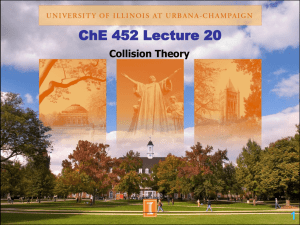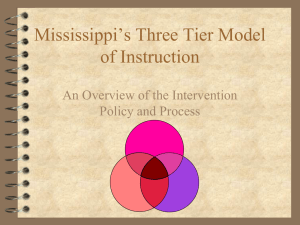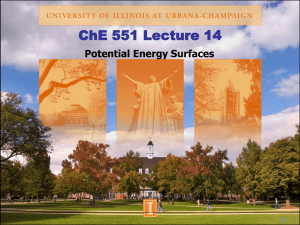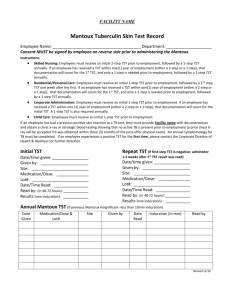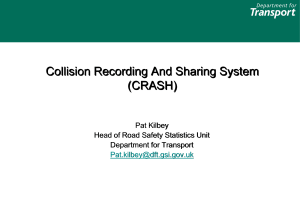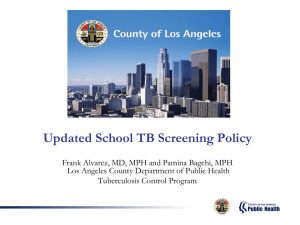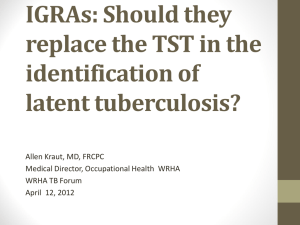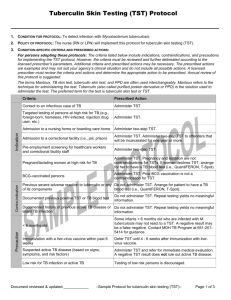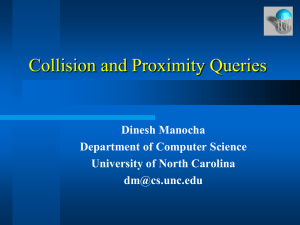che452lect23
advertisement
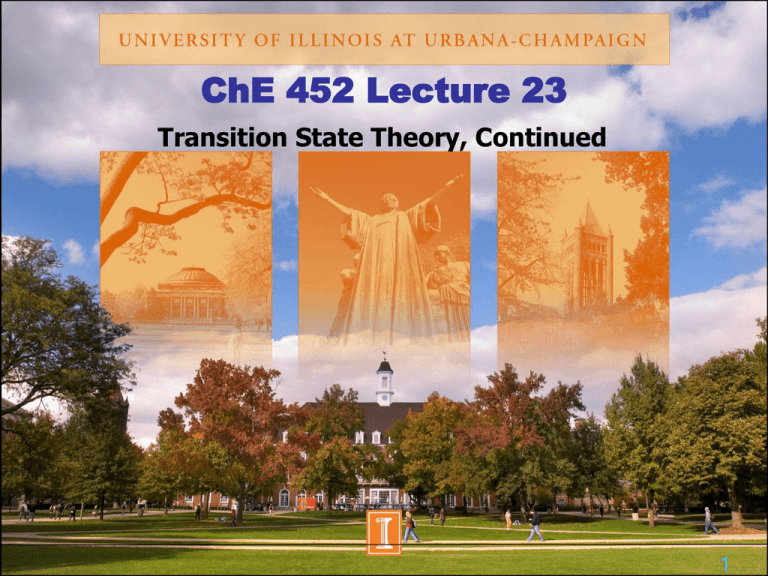
ChE 452 Lecture 23 Transition State Theory, Continued 1 Last Time Transition State Theory Energy Also called conventional transition state theory (CTST) A ‡ Barrier Reactants Products Reaction Cordinate Figure 7.5 Polanyi’s picture of excited molecules. † † T † † E k BT q k BT k A BC = e h q q p A BC (7.43) 2 Results From Last Time F+H2HF+H Table 7.C.3 A comparison of the preexponential calculated by transition state theory and collision theory to the experimental value. ko Transition state theory with adjusted transition state geometry ko Transition state theory with exact transition state geometry ko Collision theory ko Experiment 2.05 1014 Å3/mole-sec 1.65 1014 Å3/mole-sec 1.9 1014 Å3/mole-sec 2.3 1014 Å3/mole-sec 3 Comparison Of Transition State Theory And Collision Theory 1. 2. Transition state theory uses the transition state diameter rather than the collision diameter in the calculation. Transition state theory multiplies by two extra terms: The ratio of the vibrational partition function, and the electronic partition function for the transition state, and the reactants. 4 Key Prediction Of TST Ea associated with barrier Lots of parameters (i.e. qs) to fit to data. Predicts k BT =5x1012 /sec at 300 K, 1x1013 /sec at 600 K hP 0.1 < ‡ qT q AqBC < 10Å3 / molecule Preexponentials 3 3 Å Å 5x1011 < k o < 1x1014 molecule sec molecule sec 5 Is The Saddle Point Energy A Good Approximation To The Activation Energy? Table 7.4 A comparison of the saddle point energy from accurate ab-initio calculations and the activation barrier measured experimentally for a number of reactions. Reaction H + H2 H2 + H D + H2 DH + H H + CH4 H2 + CH3 H + CH3CH3 H2 + C2H5 F + H2 HF + H H + CH3CH2CH3H2 + C3H7 H + CH3OH CH2OH + H CH3 +CF3I CH3I + CF3 Saddle Point Energy kcal/mole 9.60 9.60 13.5 11.8 Ea kcal/mole 8.0 7.78 11.9 9.7 5.8 10.4 1.7 8.2 9.8 9.0 4.95 7.5 6 Difference Between EA And Saddle Point Energy Due To: Dynamic effects and quantum effects Tunneling Tail of Wavefunction Extends through barrier Center of Wavefunction before barrier B A Wavefunction Barrier Figure 7.8 A diagram showing the extent of the wavefunction for a molecule. In A the molecule is by itself. In B the molecule is near a barrier. Notice that the wavefunction has a finite size (i.e. there is some uncertainty in the position of the molecule.) As a result, when a molecule approaches a barrier, there a component of the molecule on the other side of the barrier. 7 Accuracy of TST Only Fair Very hard to get better than 1 order of magnitude 5 Experiment 2 1 0.5 0.2 0.1 0.05 0.01 0.02 0.05 0.1 0.2 0.5 1 2 5 10 Transition State Theory Figure 7.9 A comparison of the hp/kBT measured experimentally for the reactions in Table 9.4 to the transition state approximation of the same quantities. 8 Why Was Transition State So Popular? Gave a way of thinking about activation barriers. Lots of parameters to fit data. Eyring 500 papers. People thought it was right (except for tunneling). Only in 1998 did people realize that TST with tunneling is not accurate. Still thought to be a useful way of thinking about reactions. 9 One Application Of TST Is To Estimate Ko ‡ Approximate Evaluation of q qq A B Earlier in this chapter, we said that typically q is within an order of magnitude or two ‡ qq A B of unity. The object of this problem is to q evaluate using the approximations in ‡ qq A B Chapter 6 for a case where A, B and C are atoms, not molecular ligands. 10 Solution Step 1: Count The Modes Consider A+BCABC‡AB+C with a linear transition state. In lecture 14 we found that molecules have 3 vibrational modes, 2 or 3 rotational modes and 5Na total modes Molecule A BC ABC‡ Atoms 1 2 3 Total Modes 3 6 9 Translations 3 3 3 Rotations 0 2 2 Vibrations 0 1 4 11 Step 2: Find The Partition Functions A: q q A 3 t BC: q q q q 3 BC A (7.B.1) t v 2 r BC (7.B.2) Transition state: * 3 4 2 t v r TST q =(q q q ) (7.B.3) 12 Transition State Approximation; Treat One Of The Vibration Modes As A Translational Mode * A 3 3 2 t v r ABC TST q =(q q q q ) (7.B.4) Where qAAC is the partition function for the motion of A toward BC. In transition → state theory, we want q‡ not q*. By definition: ‡ q= * q q ABC 3 3 t v 2 r TST =(q q q ) (7.B.5) 13 Combining Equations 7.B.1 Through 7.B.5 Yields qqq q 3 q A q BC (q t ) A (q q q ) ‡ 3 v 2 r 3 t TST 3 2 t v r BC (7.B.6) 14 Approximation: For Today’s Example (qt)TST (qt)A (qt)BC = qt (7.B.7) (qr)TST (qr)BC (7.B.8) (qv)TST (qv)BC = qv (7.B.9) Substituting (7.B.7), (7.B.8) and (7.B.9) into equation (7.B.6) yields ‡ q q q Aq B q 2 v 3 t Take 2 translations Convert to vibrations q qq A (7.B.10) 15 Solution Continued According to Table 6.6; qv1, qt 3/Å. Substituting into equation (7.B.10) 12 q‡ Å3 = =0.037 3 q A q B (3/Å) molecule (7.B.11) 16 Solution For Nonlinear TST One can do the same analysis for a nonlinear transition state. The result is: q v q r 1x50 q‡ Å3 = 3 =1.85 3 q A q B q t (3/Å) molecule (7.B.12) 17 Estimate ko From Above Showed 0.04<q‡/qAqBC<2 kBT/h 5x1012/sec Hence 1011 and 1013/sec 18 Comparison To Experiments Table 7.2 A selection of the preexponentials reported by Wesley[1980]. Reaction Preexponential Reaction Å3/molecule Sec Preexponential Å3/molecule Sec H+C2H6C2H5+H2 1.6 1014 O+C2H6OH+C2H5 2.5 1013 H+CHH2+C 1.1 1012 O+C3H8(CH3)2CH+OH 1.4 1010 H+CH4H2+CH3 1 1014 O2+HOH+O 1.5 1014 O+H2OH+H 1.8 1013 OH+OHH2O+O 1 1013 O+OHO2+H 2.3 1013 OH+CH4H2O+CH3 5 1013 O+CH4CH3+OH 2.1 1013 OH+H2COH2O+HCO 5 1013 O+CH3H+CH3O 5 1013 OH+CH3H+CH3O 1 1013 O+HCOH+CO2 5 1012 OH+CH3H2O+CH2 1 1013 19 Not Accurate Compared To Experiments/Detailed Transition state larger than reactants Rotational partition function larger Vibration larger too 20 Strengths Of Transition State Transition state theory allows you to calculate bcoll in equation (7.16) rather than guess it. In Chapter 9, we will show that for a simple collision bcoll is just the distance between the reactants at the transition state. Transition state theory suggests that Preactions can be less than exp(E‡T /k BT) . For example, in the reaction: D+CHC+HD The incoming deuterium has to hit the hydrogen atom for reaction to occur. Transition state theory accounts for that by saying that the transition state must be a linear CHD molecule. Transition state theory also predicts that small changes in the shape of the potential energy surface produce large changes in q ‡ , which in turn changes the rate. T 21 Accuracy Of TST Only Fair Very hard to get better than 1 order of magnitude 5 Experiment 2 1 0.5 0.2 0.1 0.05 0.01 0.02 0.05 0.1 0.2 0.5 1 2 5 10 Transition State Theory Figure 7.9 A comparison of the khp/kBT measured experimentally for the reactions in Table 9.4 to the transition state approximation of the same quantities. 22 Next: Relationship Between TST And Collision Theory TST & collision theory very similar Similar predictions In fact, TST goes to collision theory if one ignores vibration and rotation of BC. Book shows that TST goes to collision theory for structureless molecules. 23 Transition State Theory Differs From Collision Theory In Two Key Ways: One can actually make a calculation. Collision theory bcoll unknown (7.16). Transition state theory replaces bcoll with dcoll. The distance between reactants at the transition state geometry. dcoll can be calculated exactly. Transition state theory allows you to consider reactions like reaction (7.27) where only special configurations lead to the desired products. Partition function for TST gives many parameters 24 Summary Transition state theory Extension of collision theory (used collision theory to derive) Identifies bcoll as dcoll Identifies S as S of saddle point Slightly, more accurate that Collision theory Still only accurate to order of magnitude 25 Question What did you learn new in this lecture? 26

